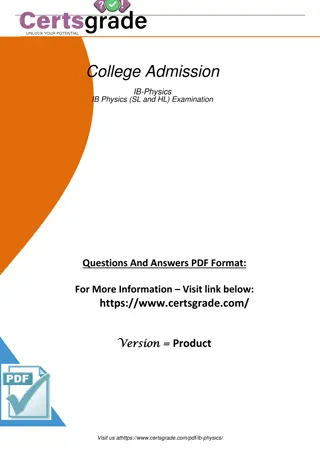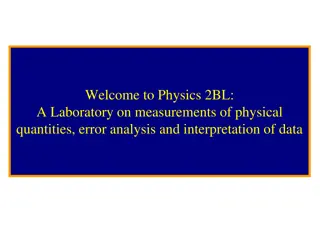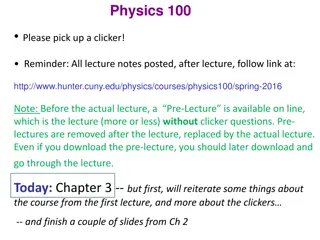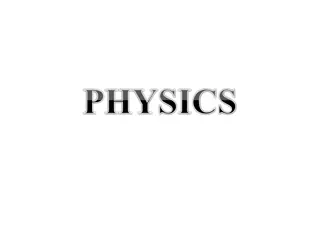College Physics Course Information
In this college physics course, you will delve into the principles of physics through experiments, lab reports, and final exams. You will learn to record and communicate experimental data accurately and independently, enhancing your understanding of physics concepts. The course emphasizes hands-on learning, lab work, and collaborative problem-solving. Make sure to follow the guidelines for lab notebooks, reports, and grading criteria outlined by the instructor. Engage with the course material, participate in group work with integrity, and strive for a deep understanding of the subject matter.
Download Presentation

Please find below an Image/Link to download the presentation.
The content on the website is provided AS IS for your information and personal use only. It may not be sold, licensed, or shared on other websites without obtaining consent from the author.If you encounter any issues during the download, it is possible that the publisher has removed the file from their server.
You are allowed to download the files provided on this website for personal or commercial use, subject to the condition that they are used lawfully. All files are the property of their respective owners.
The content on the website is provided AS IS for your information and personal use only. It may not be sold, licensed, or shared on other websites without obtaining consent from the author.
E N D
Presentation Transcript
Download the following files: Syllabus All the documents are available at the website: http://dept.swccd.edu/hlee
Introduction Wilfred Hok Kong LEE, Ph.D. Office: 343A Mail box: MSE Office 215 Contact Info: Email: hlee@swccd.edu Phone: ext. 5533 Mon 11:40 1:10 Wed 11:40 1:10 Thu 11:40 12:40
Textbook & Course Homepage Optional: Principles of Physics (5th edition), by Serway & Jewett Course Homepage: http://dept.swccd.edu/hlee Lab manuals will be posted on this site. Print out the lab manuals BEFORE you come to class. Your scores will be posted on Blackboard Online: Go to the Southwestern College homepage http://www.swccd.edu Click on Blackboard/OnlineLearning tab on the right
Grades Lab Report Final Exam 80% 20% 100 85% 84 75% 74 60% 59 50% 49 0% A B C D F
Policy on Collaboration You can work in groups, but you must write your solution independently. Students who copy or allow people to copy your work will get zero.
Lab Philosophy Not the same as a computation heavy lecture course It is NOT just about getting the final answer You are being trained to: Carefully measure experimental data Record and communicate what you do and what you discover to others If you get a very accurate result, and yet I cannot understand what you did in the lab I will not give you a passing grade.
Lab Notebook and Formal Report Buy a lab notebook from either the bookstore or online. Lab notebook is the actual and precise record of your experiment. Write during the lab as you perform every step (not at the end of the entire experiment). Lab report is similar to a paper you want to publish. Assume the readers are not familiar with your experiment. Written after the experiment. Do it at home. Read the Lab Notebook and Report file on the website. It teaches you how to write the notebook and report.
Lab Notebook Overview Must do for every lab (except simulations). Submit the duplicate copy at the end of the lab. Actual record of exactly what you did during the experiment. It is not supposed to be neat. Write in ink, not pencil. Do not erase anything. If you made a mistake, draw a thin line to cross out the mistake, and write a short justification next to it.
Lab Notebook Table of content: Leave the first two pages of the notebook for the table of content. Title, name and date: Include names of your lab partners. Purpose Setup: Typically contains diagrams. Procedure and data: Important! Record honestly, and be as careful as you can. Analysis: Typically includes calculations. Sources of error Conclusion: Less than half a page. Be quantitative. Questions: Answers questions from the manual.
Lab Notebook 1 Leave the first two pages of the notebook for a table of contents. Begin the text in the notebook for each experiment with its title and number, the date, and the name of your lab partner, if any.
Lab Notebook 2 State briefly the objective of the experiment. Five sentences or less are usually sufficient. Enter all data in your notebook in ink, using a kind that is not prone to smudge. A number alone is meaningless, without a description, appropriate units, and an associated estimate of uncertainty. Label each column in data tables and give units. Make clear diagrams of the overall experimental setup and all relevant circuits. Note the geometry, dimensions, settings of the apparatus, and conditions under which the results were obtained.
Lab Notebook 3 Use graphs to display experimental results, including labeled axes and plot points. Justify the choice of plot. A sentence like We expect the voltage V to decay exponentially with time so plot logV (voltage) vs. t(time) to obtain a straight line is all you need; Give the graph a title; Label your axes and put the units (e.g. N) in parentheses next to the axis name;
Lab Notebook 4 If you are fitting (comparing) some mathematical expression (the fitting function) to experimental points, then include the fitting function on the graph. Also include any fitting parameters with their uncertainties (errors). Finally, graph the fitting function through your experimental points and include in your report a succinct comment on the agreement between fitting function and experimental data, i.e. goodness of the fit.
Lab Notebook 5 Show how you converted the measurements into the final derived quantities. Do an error analysis on the results by using the rules for propagation of errors. A single example of each type of calculation is sufficient. If feasible, the results of calculations and accompanying errors should be presented in the form of tables. State results and comment on them including their (dis)agreement with accepted values. If your report requires a comparison between an experimental result and some expectation, then make a quantitative statement. Simply writing two results (numbers and their uncertainties) next to each other and making a remark like they re almost the same is not sufficient
Formal Lab Report Overview Not needed for every single experiment. Will be announced. Must type. Be concise. Do not exceed 5 pages, excluding diagrams and graphs.
Formal Lab Report Title page: Title, name and date. Abstract of less than 150 words. Introduction: 5 sentences or less. Theory Setup: Typically contains diagrams. Procedure Data Analysis: Typically includes calculations. Sources of Error Conclusion: Be quantitative Questions: Answers questions from the manual.
Data and Tables This section must contain the data you obtained in this experiment. You can present it in a table format. Always include units and use scientific notation when convenient. If a table is included in the manual, you should still copy the entire table to the notebook and record your data on the notebook.
Analysis and Calculations This section must contain equations and calculations you used. Please be clear and organized. Show your work. I don t want to see just the final answer. If there are more than one trial, show work for just one of them.
Multiple Trials If there are multiple trials, the calculations for each trial are almost exactly the same. No need to write the calculations for every trial. Do a sample calculation for one of the trials. Indicate which trial you are calculating, seeing that the calculations of one trial is correct, I will trust that you know how to do the rest.
Sources of Error No experiments are perfect Common errors: Friction, reaction time Unacceptable sources of error: I may have did the calculations wrong I was careless
Conclusion Provide a summary of the experiment. Compare your results with the theoretical value, if applicable. Conclusion always has something to do with the purpose section. BE QUANTITATIVE!!!
Examples of Conclusions Acceptable the measured value is within 4.7% of the accepted value . Newton s Second Law is verified to within 3% . quantitative Unacceptable the measured value is pretty close to the accepted value , or Newton s Second Law is correct too vague
Questions Put your answers to the questions on the lab manuals after the conclusion section.
Diagrams Diagrams are usually expected in description of the setup or sometimes in the procedures as well Can be drawn by hand or computer Give the diagram a title, and a brief description Number the diagram (e.g. Figure 1)
Graph Graphs are usually very important Should be drawn by computer Graphs must have title, axis labels (with units) DO NOT use like P vs T , use descriptive title so people know what it is about immediately. Number the graph (e.g. Figure 1) A sentence or two stating the main conclusion from the graph, like Pressure is seen to be proportional to the temperature. Ideal Gas Law at Constant Volume 20 y = 1.9048x + 0.4286 R = 0.9895 15 Pressure (atm) 10 Tab y = 0.9583x + 2.3472 R = 0.9801 5 0 0 5 10 15 Temperature (K)
Some (very) simple error analysis For those who are interested: http://www.upscale.utoronto.ca/PVB/Harrison/ErrorAnalysis/ http://www.ligo.caltech.edu/~vsanni/ph3/ You can download notes about data analysis from these sites.
Percentage difference Often one wants to compare two numbers, e.g. u=12.4 and v=13.1 by evaluating their percentage difference. 12.4 -13.1 12.4 or 12.4 -13.1 13.1 Both are correct. Usually when we calculate percentage difference, the two numbers are very similar in value, so it does not matter which one we put in the denominator. 100% = 5.6% 100% = 5.3%
Some common mistakes Correct: 12.4 -13.1 12.4 or 12.4 -13.1 13.1 Incorrect : 12.4 -13.1 12.4 or 12.4 -13.1 13.1 or 12.4 -13.1 12.4 100% = 5.6% 100 = 5.6% 100% = 5.3% 100 = 5.3% 100% = -5.6% The % sign is NOT optional, nor is the absolute value sign.
Detailed Error Analysis See the file Error Analysis.pptx . Calculate the uncertainty of your final results.




























